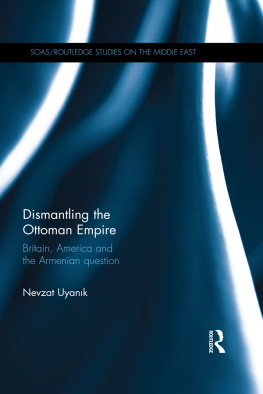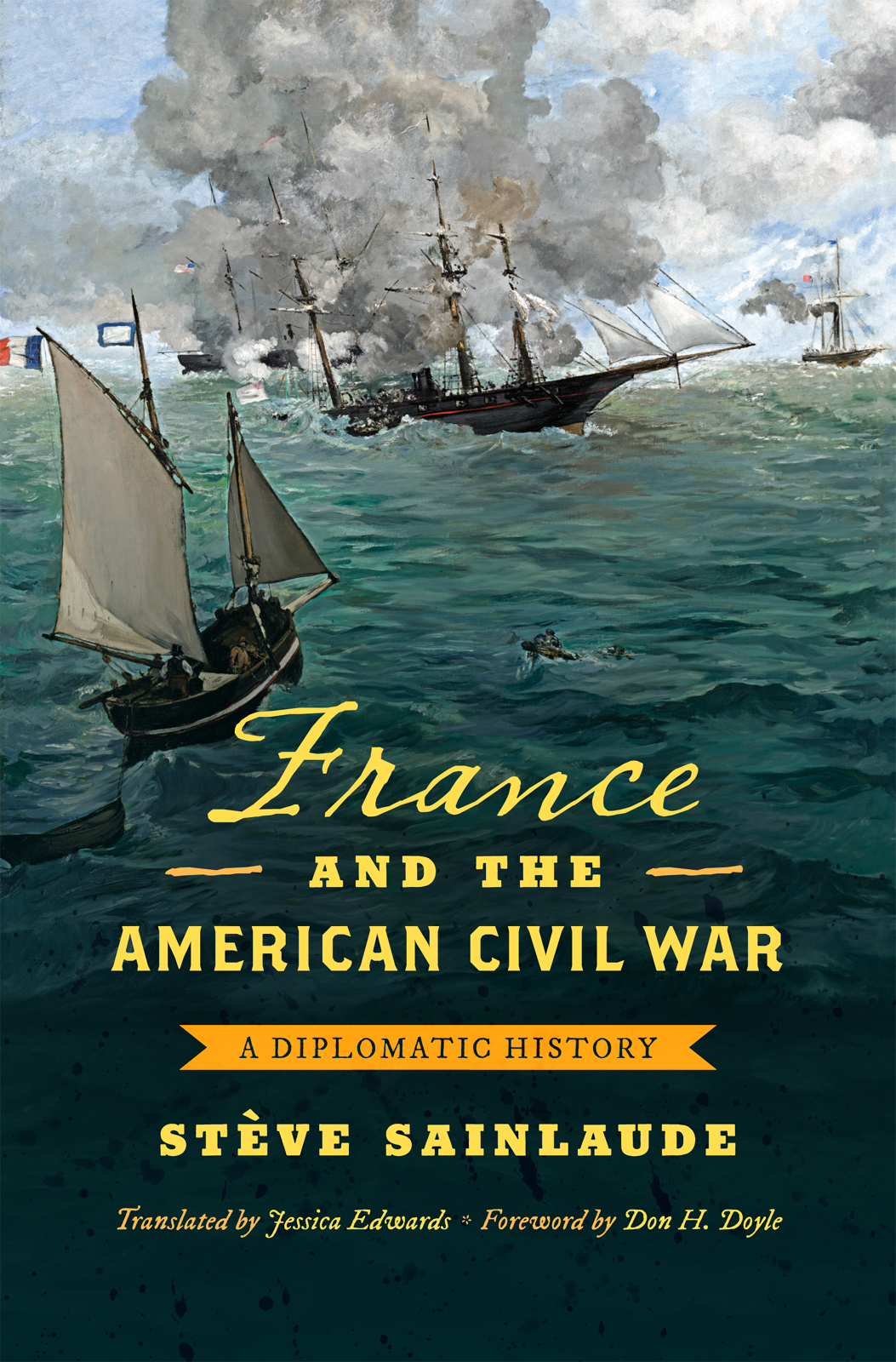This landmark series interprets broadly the history and culture of the Civil War era through the long nineteenth century and beyond. Drawing on diverse approaches and methods, the series publishes historical works that explore all aspects of the war, biographies of leading commanders, and tactical and campaign studies, along with select editions of primary sources. Together, these books shed new light on an era that remains central to our understanding of American and world history.
France
AND THE
AMERICAN CIVIL WAR
A DIPLOMATIC HISTORY
STVE SAINLAUDE
Translated by Jessica Edwards * Foreword by Don H. Doyle
THE UNIVERSITY OF NORTH CAROLINA PRESS Chapel Hill

Publication of this book was supported in part by a generous
gift from Anne Faircloth and Fred Bejeu-DuFour.
Translation of this book was supported by a grant from the Anonymous Trust.
2019 The University of North Carolina Press
All rights reserved
Designed by Jamison Cockerham
Set in Arno, Dear Sarah, Brothers, Cutright, and Scala Sans
by Tseng Information Systems, Inc.
Manufactured in the United States of America
The University of North Carolina Press has been a member
of the Green Press Initiative since 2003.
Cover illustration: douard Manet, The Battle of the USS Kearsarge and
the USS Alabama, 1864, courtesy of the Philadelphia Museum of Art,
John G. Johnson Collection, Cat. 1027. (Also appears on pages .)
LIBRARY OF CONGRESS CATALOGING-IN-PUBLICATION DATA
Names: Sainlaude, Stve, author. | Edwards, Jessica, translator. | Doyle, Don Harrison, 1946, writer of introduction. | Sainlaude, Stve. Gouvernement imprial et la guerre de scession (18611865) English. | Sainlaude, Stve. France et la Confdration sudiste, 18611865. English.
Title: France and the American Civil War : a diplomatic history / Stve Sainlaude ;
translated by Jessica Edwards ; foreword by Don H. Doyle.
Other titles: Civil War America (Series)
Description: First edition. | Chapel Hill : The University of North Carolina Press, [2019] |
Series: Civil War America | Includes bibliographical references and index.
Identifiers: LCCN 2018040232| ISBN 9781469649948 (cloth : alk. paper) |
ISBN 9781469649955 (ebook)
Subjects: LCSH: FranceForeign relationsUnited StatesHistory19th century. | FranceForeign relationsConfederate States of America. | United StatesForeign relationsFranceHistory19th century. | Confederate States of AmericaForeign relationsFrance. | United StatesForeign relations18611865. | FranceForeign relations18521870.
Classification: LCC DC59.8.U6 S25513 2019 | DDC 973.7/20944dc23
LC record available at https://lccn.loc.gov/2018040232
A variation of this work originally appeared in French in two books by Stve Sainlaude, Le gouvernement imprial et la guerre de Scession (18611865) and La France et la Confdration sudiste (18611865) Editions lHarmattan.
Both books were awarded the Prix Napolon III prize in 2013.
To my parents
who never forgot what the United States did for France
that morning in June 1944
How great and holy is the mission, and how worthy of inspiring mans ambition, that consists in mitigating evil passions, in healing wounds, in calming the sufferings of humanity, in uniting the citizens of one country in a common cause, and in hastening a project which civilization must sooner or later accomplish.
LOUIS NAPOLON BONAPARTE,
Extinction of Pauperism, 1844
Contents
Illustrations
The Reception of Queen Victoria by Napolon III
at Saint-Cloud, August 18, 1855
Proclamation of the Abolition of Slavery in the
French Colonies, 27 April 1848
Foreword
Americas Civil War was much more than a military conflict between the North and South. From the outset the American Question, as foreign powers called it, involved multiple European empires and the young nations of Latin America in matters of diplomacy, commerce, and geopolitical strategy. It soon became apparent to foreign observers that the insurrection of Southern slaveholders was not going to be easily put down and would become a protracted conflict. Though they remained officially neutral, most of the European powers were betting on the South to win, not by military prowess so much as sheer determination to outlast the North.
The aristocratic European governing classes despised Americas brand of democracy and were delighted to see the so-called Great Republic tearing itself apart, and they instantly recognized the Civil War as an unexpected opportunity for European empires to reclaim lost American colonies or otherwise project their power in the New World. From its stronghold in Cuba, Spain swept into its former colony the Dominican Republic even before the attack on Fort Sumter. Later, Spains navy provoked wars with Peru and Chile, part of a strategy to reassert Spanish power in South America. Britain nearly went to war with the United States in December 1861 after a U.S. Navy ship apprehended a British mail packet, the RMS Trent, which was carrying two Confederate envoys to Europe. While war fever reached its peak, Britain took the opportunity to send 10,000 troops to Canada and fortify its navy in the Caribbean.
In October 1861, Spain, Britain, and France sent delegates to London to create the Tripartite Alliance, a military pact whose mission was to invade and occupy Mexico, supposedly to recover debts. The Mexican republic was recovering from its own civil war, the Guerra de Reforma (185760), and was forced to suspend interest payments to creditors for two years. Napolon III, the mercurial emperor of France, had more in mind than recovering debts. He saw in Mexico the key to his Grand Design, which would have France leading the Latin race in the New World and Europe, countering the influence of Anglo-Saxons in both spheres. The Latin temperament, according to French imperial thought on this matter, was wholly unsuited to republicanism and could only be governed by a monarch sustained by the moral authority of the Catholic Church.
Mexico had been through some fifty changes of government since breaking with Spain in 1821 and had endured a long civil war in which the Conservative Party (also known as the Church Party) rebelled against the Liberal Party and its program of reform that vastly reduced the power of the church. After the conservatives lost, they sought help from Europe, which led to Napolon IIIs fateful decision to install the Austrian Habsburg Archduke Maximilian as monarch of the Mexican Empire. Napolon would never have considered such a venture were the United States not consumed by civil war. The United States feared that to oppose French intervention in Mexico might throw Napolon III into the arms of the Confederacy.
In many respects, Napolons Grand Design depended on the success of the Confederacy. John Slidell, the Confederate envoy in Paris, invited the French emperor to make war against their common enemy, the United States. Having realized that antislavery sentiment in Britain spoiled chances of an alliance, the Confederacy shifted its attention to France in 1863. Its envoys and propagandists in Europe flattered the French with the idea that the South, with its Louisiana Creole, South Carolina Huguenot, and Anglo-Norman heritage shared a natural Latin antipathy toward the fanatical Puritan zealots to their North. To sweeten the deal, the Confederacy authorized Slidell to offer a lucrative cotton bribe exclusively to France, if it would break the Union blockade and ally with the South against the United States.










